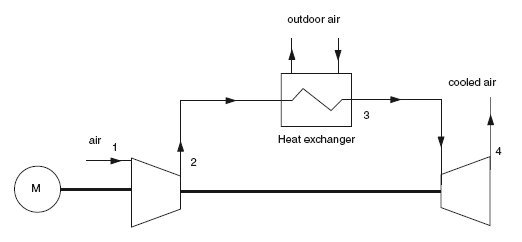Reverse Brayton cycles
As its name implies, a reverse Brayton cycle achieves a cooling effect by reversing the gas turbine Brayton cycle: a gas is compressed, cooled, and then expanded (Figure below). The end of expansion temperature being low, this gas can be used to cool an enclosure, either by direct contact, especially if it is air, or through a heat exchanger.

Consider for example an open reverse Brayton cycle used to cool the passenger compartment of
an automobile to reduce CO2 emissions. The working fluid is air which undergoes the following processes:
1–2 adiabatic compression at 2.5 bar in a compressor of polytropic efficiency 0.875;
2–3 isobaric cooling of the compressed air with outside air in a heat exchanger;
3–4 adiabatic expansion in a turbine of polytropic efficiency 0.875.
The Thermoptim synoptic view of such a cycle is given in Figure below. The interior of the vehicle is represented by process “useful effect”. Air at 40 °C is sucked by the compressor and exits at about 150 °C. External cooling via a water heat exchanger allows the air fl ow to be cooled at 56 °C. It is then expanded in the turbine and exits at -3°C. This cold air is then blown into the cabin.
As can be seen, the cycle efficiency is not very high (0.85), but the system is relatively simple, and has moreover the advantage of not releasing any greenhouse gases in the event of accidental breakage of pipes.
Air reverse Brayton cycle was until recently widely used in aircraft for in flight cabin air conditioning.
Exercises and personal activities
An exercise is proposed. Its correction will provide the Thermoptim files allowing you to model the cycle presented above
A second exercise dealing with a closed reverse Brayton helium cycle is presented in the thematic page on cryogenics.
References
M. S. BHATTI, Open Air Cycle Air Conditioning System for Motor Vehicles, Society of Automotive Engineers, SAE Technical Papers, Document Number 980289,1998

